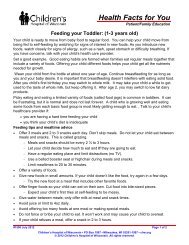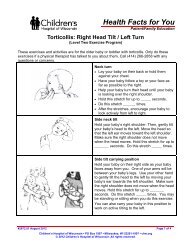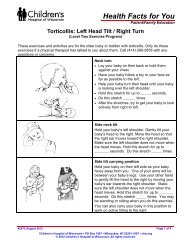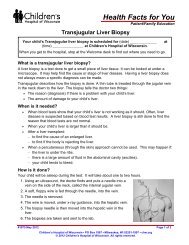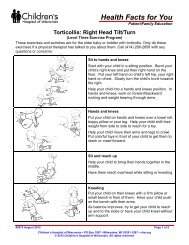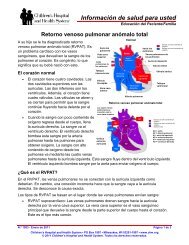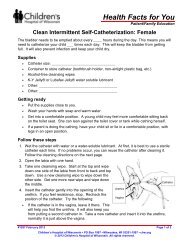Fine Motor Skill Delay - Children's Hospital of Wisconsin
Fine Motor Skill Delay - Children's Hospital of Wisconsin
Fine Motor Skill Delay - Children's Hospital of Wisconsin
- No tags were found...
Create successful ePaper yourself
Turn your PDF publications into a flip-book with our unique Google optimized e-Paper software.
What are fine motor skills?<strong>Fine</strong> <strong>Motor</strong> <strong>Skill</strong> <strong>Delay</strong>Health Facts for YouPatient/Family Education<strong>Fine</strong> motor skills are skills that are needed to handle small objects, or do detailed work withyour hands and fingers. Examples are writing, drawing, using scissors, buttoning shirts, tyingshoes and stringing beads.What is a delay and what causes it?Most <strong>of</strong>ten, children learn fine motor skills around a certain age. When they are not able to dothese skills around that age, it is called a delay. <strong>Delay</strong>s may be caused by weak handmuscles.What can be done?Exercises can help children strengthen their hands and improve control.You can do many <strong>of</strong> these exercises at home with your child. A therapist will recommend thebest ones for your child and teach you how to do them. Some are listed here.Hand strength activitiesThese include thumb and finger grasping or pinching:• String beads or fruit loops, etc. on a string or piece <strong>of</strong> yarn.• Find buttons or coins in therapy putty and put them into slots in c<strong>of</strong>fee can lid. Thetherapist will show you how to use therapy putty to do hand exercises.• Play with a Lite-Brite® game.• Put small beans or pellets into bottles or containers.• Pinch clothespins to put them on and take them <strong>of</strong>f <strong>of</strong> a string, paper or cloth.• Peel and put stickers on paper.• Play with a potato head doll.• Draw on a chalkboard or a piece <strong>of</strong> paper on the wall. Use small pieces <strong>of</strong> chalk or smallbroken pencils.• Connect the dots in a dot-to-dot drawing. You can make the drawings yourself usingsimple pictures, like a kite or ball.• Use a tweezers or tongs to pick up small items like beans, buttons, Lego’s ® , etc.• Use nuts and bolts. Have your child screw the nuts on and <strong>of</strong>f the bolts.• Play with Colorforms®. You can put them on a window or mirror.#1165 November 2011 Page 1 <strong>of</strong> 2Children’s <strong>Hospital</strong> and Health System • PO Box 1997 • Milwaukee, WI 53201-1997 • www.chw.org© 2011 Children’s <strong>Hospital</strong> and Health System. All rights reserved.
<strong>Fine</strong> <strong>Motor</strong> <strong>Skill</strong> <strong>Delay</strong>Many <strong>of</strong> the items used in these exercises are small and may be choking hazards. Watchyour child closely when they are doing their exercises. Put the small items out <strong>of</strong> reach whennot doing the exercises.In-hand manipulation skills• Color in small circles about this size: O• Build with small Lego toys.• Sort cards during card games.• Play games to sort small beads, buttons or beans.– Put three to four <strong>of</strong> the items in the palm <strong>of</strong> your child’s hand. Have your child grabeach item from their palm with their fingertips.Scissor skills• Cut drinking straws or old playing cards into small pieces.• Cut thick paper such as magazine inserts.Always watch your child when they are using scissors. Use children’s scissors with roundedtips. Position your child’s hand with the thumb up.Handwriting skills• Connect dots to form shapes.• Draw letters with fingers on different textures such as sandpaper or felt.• Put salt, shaving cream or fingerpaint on a tray and draw letters and numbers.• Squeezing a bottle <strong>of</strong> glue or thick paint, have your child trace letters on paper. Once theglue is dry, have your child close their eyes and use their finger to trace the letters. Youcan also glue yarn in the shape <strong>of</strong> letters to trace and feel.ALERT: Call your child’s therapist, doctor, nurse, or clinic if you have anyquestions or concerns or if your child has special health care needs that werenot covered by this information.This teaching sheet is meant to help you care for your child. It does not take the place <strong>of</strong> medical care.Talk with your healthcare provider for diagnosis, treatment, and follow-up.#1165 November 2011 Page 2 <strong>of</strong> 2



